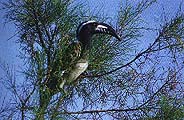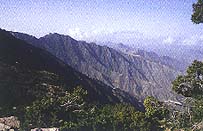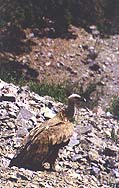by Dr. Graham R. Lobley
Pictures by NWRC & Dr. Graham R. Lobley
The unique blend of Palearctic and Ethiopian birds to be found in the west of the Kingdom provides compelling interest throughout the year. It is possible to see around 250 bird species annually in this region of Saudi Arabia, from Jeddah southwards. The breathtaking scenery, historical interest, superb quiet roads and personal safety are further incentives to explore and document this little-known area.
 The Tihama
The Tihama
The extensive sandy Tihama plains hold Hoopoe Lark and Black-crowned
Finch Lark, with wintering Desert Wheatear, Isabelline Shrike
and Long-legged Buzzard. Further inland, Chestnut-bellied Sandgrouse
is the characteristic Tihama bird. Large flocks come in for their
morning drink between 8.00 and 9.00 a.m. at favoured locations
in certain wadis and seasonal ponds. This behaviour is one of
the most spectacular birding sights anywhere - it is amazing to
witness large numbers of birds suddenly appear from various directions
of the surrounding, seemingly barren plains and hills. Cream-coloured
Courser and Steppe Eagles also occur in winter, whilst the areas
around boulder outcrops are good for typical residents, such as
Blackstart, Sand Partridge and even Little Green Bee-eater.
Further south, in the Asir Tihama around Sabya especially, Arabian Golden Sparrow, Dark Chanting Goshawk and Abyssinian Roller are additional possibilities. Small flocks of the delightful golden-yellow sparrows can sometimes be seen on acacias and in adjacent cropfields. The beauriful White-throated Bee-eater is a breeding summer visitor to the Asir Tihama. A reliable place to search for this species is around Muhayl. In nearby villages, bee-eaters can sometimes be seen perching on telegraph wires.
Drainage from the Sarawat mountains runs predominantly westwards, but most wadis are dry for much of the year. The larger ones, such as wadi Al Lith, maintain a good flow in their upper reaches for long periods throughout the year. These wadis have resident Hamerkop and attract migrating Black Stork. Birds such as Masked Shrike may over-winter and Arabian Warblers are fairly common.
One of the most intersting wadis of all, from a bird-watching viewpoint, is wadi Uranah. This carries treated waste water from Makkah and is consequently no longer seasonal over much of its length. The wadi is accessible 80 km from Jeddah along the Makkah bypass road to Taif. There is significant branching and flooding in the flatter sections of some parts of the wadi and these wetlands have created an excellent year-round habitat. White-tailed Plover and Marsh Harrier over-winter and both Spur-winged Plover and Black-winged Stilt are breeding residents, with Chestnut-bellied Sandgrouse guaranteed all year. Ducks include wintering Teal and Pintail and migrant Garganey and Ferruginous Duck. This area is excellent for migrants, including Olivaceous and Olive-tree Warbler, Collared Pratincole, Golden Oriole, Blue-cheeked Bee-eater and possibly Caspian Plover. In addition to Desert Wheatear and possible Trumpeter Finch, the drier side wadis in this area hold wintering Red-rumped, Red-tailed and White-crowned Black Wheatears.
Wadis in the foothills closer to the base of the escarpment hold further interest, with Cinnamon-breasted Rock Bunting and Grey Hornbill as new possibilities. In Dhi-Ain, at the Baha ascent of the escarpment, a permanent stream irrigates a mature banana and palm plantation. The cultivated area and immediate surroundings below the uninhabited hill village are lush and tropical and hold a number of exotic and colourful birds, including Shining Sunbird, Bruce's Green Pigeon, Grey Hornbill, Amethyst Starling and Grey-headed Kingfisher. The latter two species are summer visitors. Such bird species are mainly African in their distribution and this emphasizes the strong faunal links of this part of western Arabia with Africa. Lasting images are of a flock of the beautiful green and yellow pigeons flying around against the vivid blue sky of early morning or a kingfisher, with its iridescent cobalt blue wings and tail, flashing by to seize its prey, of mainly lizards and large insects. The top quality bird-watching and the sheer beauty of this outstanding location will draw you back time and time again.
 The Escarpment
The Escarpment
Wadis on the escarpment itself should also be investigated. A
superb wadi is located 7 km from the check point up the Taif escarpment
road. A walk up this wadi of about 1 km from the road intersection
reveals a rich, well preserved habitat comprising a semi-permanent
stream, extensive old acacias and some mature fig trees, the latter
dotted along the boulder-strewn valley floor. Arabian Woodpecker
and Arabian Serin immediately capture interest as endemics and
the area holds an excellent selection of other birds. In January,
male Cinnamon-breasted Rock Buntings have been noted singing from
prominent song-perches, suggesting imminent breeding. The ancient
camel caravan route up the escarpment is well-preserved in this
valley. Built as-well as a Roman road with jointed slabs of granite
and retaining side-walls and steeped in millennia of virtually
unchronicled history, it is interesting to compare this old camel
track with the nearby modern road.
There are dramatic scenic overhanging cliff-faces from the escarpment rim all the way south from Taif to Abha and beyond. A typical one, 75 km north of Baha, holds Griffon Vulture, Fan-tailed Raven and a pair of Barbary Falcons, with Tristram's Grackles everywhere. Raptor watchers at the cliff edges will appreciate the perfect views of the birds from both above and below.
Some of the birds of the juniper woodlands on the escarpment rim zone have already been mentioned. Elsewhere, the highlands, with attractive walled terraces around rich fertile fields, have been extensively cultivated for around 2500 years. Surrounding areas are home to Red-breasted and South Arabian Wheatear. The clement year-round weather in these highlands is similar to the Mediterranean summer and this image is completed with breeding Red-rumped Swallow and Hoopoe. The endemic Philby's Rock Partridge also occurs in the wilder sections.
The Jebel Souda section of the Asir National Park, near Abha, will greatly repay investigation. At least five bird species endemic to the Arabian peninsula can be seen during a couple of hours of early morning bird-watching on Souda. These include Yemen Linnet and Yemen Thrush, which are both quite common in the junipers on the plateau near the rim. By visiting the main overlook close to the car park just after sunrise, the shyer Arabian Red-legged Partridge can normally be seen feeding on the ground close to the rim. Small coveys of these birds occasionally fly across the rim zone. From a spectacular cliff overlook close to the luxury hotel on Souda, one can also expect good views of the diminutive Yemen Serin picking around the vegetation clinging to the precipitous rock faces in its search for seeds.
Just south of Tanuma, between Baha and Abha, the waterfall of Al Dahna and the lush small valley are perfect compact places to bird, conveniently located just over a 100 m from the main road. Amethyst Starling, Little Rock Thrush, Yemen Thrush, Alpine Swift and White-breasted White-eye all occur. The premium birds here are Spotted Eagle Owl and Asir Magpie. Restricted entirely to the mountains of south-western Saudi Arabia, the Asir Magpie (Pica pica asirensis) is a separate race from its northern relative and has a distinctive call and heavier bill. Even the endangered Bald Ibis has been recently reported in winter from this location.
Wadi Turabah is one of the few larger wadis draining eastwards. The upper reaches of this wadi are breathtakingly beautiful with permanent water and resident Hamerkop. Typical birds include Palestine sunbird and South Arabian Wheatear; Verreaux's Eagle occur here and the Grey-headed Kingfisher is a breeding summer visitor.
 The Plateau
The Plateau
Moving eastwards from the escarpment mountains, there is an extensive,
high flat plain, sloping gently eastwards. The main vegetation
here is scattered acacia trees and milkweed shrubs.
During winter months, this gently sloping high plateau receives some rainfall. Several seasonal wadis such as Wadi Bishyan, east of Taif, drain eastwards from the mountains. The area around Wadi Bishyan supports a greater density of fairly tall acacia trees, producing striking visual images reminiscent of the more arid areas of East Africa. In this kind of habitat, large raptors such as wintering Imperial Eagles and perhaps even Lappet-faced Vultures may be seen. A rubbish dump down the Haden road is a good place to look for these majestic birds and other commoner raptors, such as Egyptian Vulture and Steppe Eagle.
Web Links | Subjects | Search
Arabian Wildlife. Volume 2, Number 2